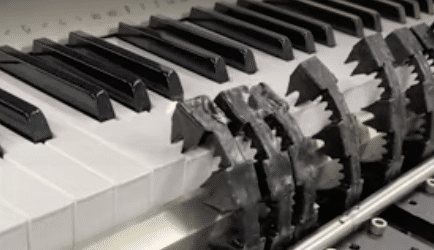The RAM chip is made using microfluidic valves instead of electronic transistors.
Engineers at the University of California -Riverside have developed an air-powered computer memory that can be used to control soft robots. The work is published in the open-access journal, PLOS One.
According to the researchers, the innovation overcomes one of the biggest obstacles in the advancements of soft robotics which is the mismatch between pneumatics and electronics.
Existing systems for controlling pneumatic soft robots still use electronic valves and computers to maintain the position of the robot’s moving parts. These electronic parts add considerable cost, size, and power demands to soft robots, limiting their feasibility.
The team led by bioengineering doctoral student Shane Hoang, his advisor, bioengineering professor William Grover, computer science professor Philip Brisk, and mechanical engineering professor Konstantinos Karydis, developed a system that could successfully overcome this hurdle.
Pneumatic soft robots need a way to remember and maintain the positions of their moving parts. The researchers believed that if they could create a pneumatic logic “memory” for a soft robot, they could eliminate the electronic memory currently used for remembering and maintaining the positions of their moving parts.
The researchers made their pneumatic random-access memory (RAM) chip using microfluidic valves instead of electronic transistors. The microfluidic valves were originally designed to control the flow of liquids on microfluidic chips, but they can also control the flow of air. The valves remain sealed against a pressure differential even when disconnected from an air supply line, creating trapped pressure differentials that function as memories and maintain the states of a robot’s actuators. Dense arrays of these valves can perform advanced operations and reduce the expensive, bulky, and power-consuming electronic hardware typically used to control pneumatic robots.
After modifying the microfluidic valves to handle larger airflow rates, the team produced an 8-bit pneumatic RAM chip able to control larger and faster-moving soft robots and incorporated it into a pair of 3D-printed rubber hands. The pneumatic RAM uses atmospheric-pressure air to represent a “0” or FALSE value, and vacuum to represent a “1” or TRUE value. The soft robotic fingers are extended when connected to atmospheric pressure and contracted when connected to a vacuum.

By varying the combinations of atmospheric pressure and vacuum within the channels on the RAM chip, the researchers were able to make the robot play notes, chords, and even a whole song.
This system could be used to operate other robots without any electronic hardware and only a battery-powered pump to create a vacuum. According to the team, using this technology, Robots could be made safe for delicate use on or around humans, such as wearable devices for infants with motor impairments.





